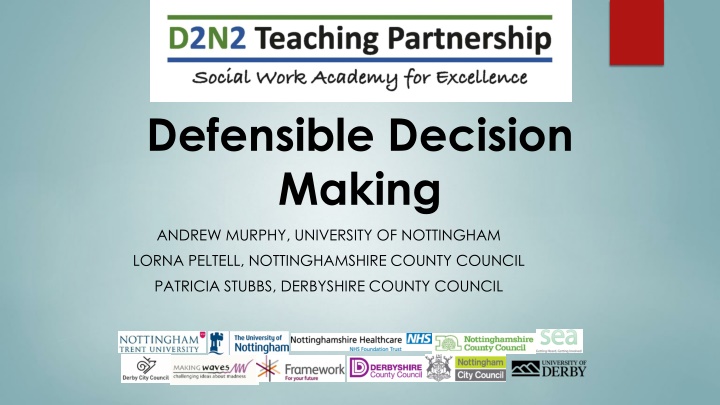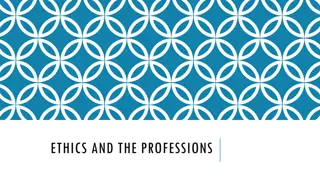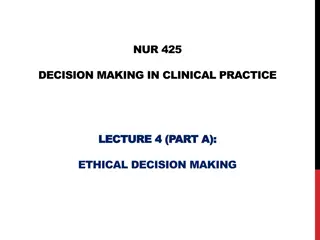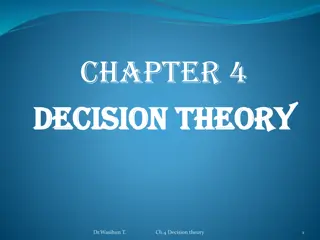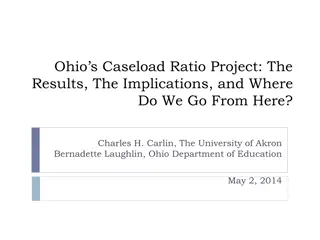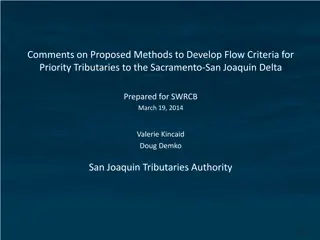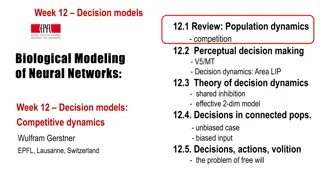Effective Defensible Decision Making in Professional Practice
Explore the concept of defensible decision making in professional practice, encompassing the process, importance of evidence-based decisions, and strategies for justifying and recording decisions to withstand scrutiny. Understand the distinction between defensible decision making and defensive practices, emphasizing the significance of professional judgment and analysis in making informed choices.
Download Presentation

Please find below an Image/Link to download the presentation.
The content on the website is provided AS IS for your information and personal use only. It may not be sold, licensed, or shared on other websites without obtaining consent from the author.If you encounter any issues during the download, it is possible that the publisher has removed the file from their server.
You are allowed to download the files provided on this website for personal or commercial use, subject to the condition that they are used lawfully. All files are the property of their respective owners.
The content on the website is provided AS IS for your information and personal use only. It may not be sold, licensed, or shared on other websites without obtaining consent from the author.
E N D
Presentation Transcript
Defensible Decision Making ANDREW MURPHY, UNIVERSITY OF NOTTINGHAM LORNA PELTELL, NOTTINGHAMSHIRE COUNTY COUNCIL PATRICIA STUBBS, DERBYSHIRE COUNTY COUNCIL
Outline What is defensible decision making? Some definitions What makes a decision defensible : The process of making a decision What happens after you make it: recording and evidencing it. Top tips
What decisions are we talking about? Self-contained : e.g. whether to disclose information to a third party Larger decisions, with potentially multiple decisions required: e.g. considering the viability of a child s placement But also what might not seem like decisions: e.g. No Further Action is also a decision
What is a defensible decision? Some definitions Kemshall (2009): Decisions that will withstand the harsh scrutiny of hindsight bias in the event of a risk failure .informed, balanced, proportionate and just risk decisions . Cooper, 2011: Critical, reflexive and careful judgements with the fully considered evidence of incomplete knowledge so that you can defend and justify your assessments, plans and interventions .
So, what is a defensible decision? One that is evidence based , which uses all the information available/discoverable to you at the time (while being aware that we rarely have all the information); Where the information has been thoroughly evaluated and analysed; Which has weighed up different outcomes and options before deciding; Which evidences the rationale for the decision , including anyone consulted (e.g. your manager); Follows policy and legislative responsibilities/duties; Is recorded in a way which evidences all the above.
Defensible decision making is not Defensive practice: for example covering your back , though its often thought of in this way. It does not mean avoiding positive risk taking or uncertainty: because we can t! Making the 'correct' decision: when we make a decision, we don t have the benefit of hindsight. We don t know what will happen. We may, in the light of later events or evidence , have made a decision that had an untoward outcome. However, if we can justify our decision making, it will be a defensible decision.
Defensible decision making: professional judgement and analysis How do we make decisions? The Rational Model Evaluate options, including likelihood of outcomes and select option Implement and evaluate the chosen option Identify the problem/issue: gather data Generate options for action
What are the problems with rational' decision making? It s not that simple: there are things that affect our ability to make a rational decision: Information availability: in social work, we don t have all the information. It may be withheld by service users, we might not ask the right questions, other agencies may have information that we aren t aware of /don t ask for. So often we are making decisions based on partial information 1. Being able to weigh up options: we often rely on our personal experience and practice wisdom to evaluate what works. Social work in many areas lacks a robust research evidence base to draw on: and many professionals don t/can t easily access research. (DfE 2014) 2.
Things that can affect your analysis of information: heuristics Heuristics: these are practical decision-making shortcuts which we all adopt as a way of dealing with lots of information. Examples include: Using our 'intuition' Drawing on previous experience of 'what works' Using stereotypes to help predict outcomes Heuristics are especially important in social work, because we have to make multiple decisions in a typical day, weighing up lots of information
So what's the problem with heuristics? We need to be aware of the potential impact of bias: do we favour options that we usually use? What other solutions might there be? We all use intuition, but gut feeling on its own is hard to evidence. One way of doing this is to use evidence to test out our intuition. Which leads onto .
Confirmation bias Is the tendency to search for, favour and recall information that confirms our preferences and beliefs. We often develop an initial hypothesis about a situation: for example Jackie is a loving parent or Steve lacks mental capacity . Confirmation bias means we may unconsciously search out information which backs up this hypothesis and disregard (or downplay) information which contradicts it. Another factor is satisficing (see Munro, 2008): this is the process of discontinuing information gathering/analysis once we have determined a good enough judgment. Do work pressures mean we might do this too soon? What does good enough mean to different people?
Decision-making tools Your employer may require you to use specific decision-making tools (such as ones derived from Signs of Safety or Systemic Practice). If this is the case, using these is a crucial part of defensible decision making: i.e. you are following your employer s policies. If your employer does not require specific decision making tools, here are some examples you could consider
Balance sheet decision making tool These are often used as evidence for courts, such as Family Courts and the Court of Protection They involve weighing up each option available and analysing the advantages and disadvantages of each. It s important that each of these are weighed up and analysed: each advantage/disadvantage will have a different impact. It s not just a matter of choosing the option with the fewest disadvantages. For example, what is the overall impact of this option on the child?
Balance sheet decision making tool: example format (from ADASS, 2015 p. 11)
Decision Trees Decisions trees are a way of analysing potential options and estimating the likelihood and desirability of the consequences of each option. They can be very detailed: they work best for complex decisions A numeric value can be given to the probability of each option and the severity of the potential consequence to give a utility value . Munro (2008 p. 105) suggests there are 7 stages to a decision tree: What is the decision? What options are there? What information is needed to help make the choice? What are the likely/possible consequences of each option? How probable is each consequence? What are the pros and cons of each consequence? The final decision 1. 2. 3. 4. 5. 6. 7.
Recording your decision Recording within your employers social care records system is a vital part of defensible decision making If you are later asked to justify your decision making (e.g. in court or to a Coroner), the absence of a written record will weaken your evidence. A quote about doctors which is equally valid for social work: Courts have a tendency to believe the memory of a patient, for whom it is a once in a life time experience, rather than the memory of a doctor, recalling many years later one of many similar procedures . (Medical Protection Society)
Recording a defensible decision Compliance with your employer s recording systems is important: ensure that you consider for example writing up as soon as possible after events, including who has been consulted etc. Cover what has been decided, but also why: the rationale for the decision: How have you come to this decision? What information have you used in making this decision? What other options are there, and why do you evaluate they are not viable? Increasingly email trails are used as evidence of decision making. Be careful though: they may cover what has been decided and who has been consulted, but does it cover the rationale?
Top tips for making a defensible decision Evaluate the information you are using: are there any gaps? How reliable are the sources? Consider who you need to communicate with to make the decision: for example family members, professionals, other teams. Ensure once the decision is made that it is communicated to the people/agencies who need to know. Consider your own biases and preferences: might these be affecting your decision? Use reflective supervision to evaluate your decision making and the impact of your values and experience. Record your decision! Ensure the rationale for your decision is clear in your recording. Evidence what other options have been considered. 1. 2. 3. 4. 5. 6. 7.
Sources used ADASS (2015), The Mental Capacity Act Deprivation of Liberty Safeguards: Guidance to the Forms, https://www.adass.org.uk/media/4436/final-dols-guidance-2015.pdf Cooper, B. (2011) Criticality and reflexivity: best practice in uncertain environments , in Seden, J., Matthews, S., McCormick, M. and Morgan, A. (eds) Professional Development in Social Work: Complex Issues in Practice, London, Routledge, pp. 17 23. DfE (2014), Clinical Judgement and Decision-Making in Children s Social Work: An analysis of the front door system, https://assets.publishing.service.gov.uk/government/uploads/system/uploads/attachm ent_data/file/305516/RR337_-_Clinical_Judgement_and_Decision- Making_in_Childrens_Social_Work.pdf [20.12.18] Kemshall, H. (2009), Working with sex offenders in a climate of public blame and anxiety: How to make defensible decisions for risk, Journal of Sexual Aggression, 15:3, 331-343 Munro, E. (2008): Effective Child Protection (2ndEdition), London: Sage.
